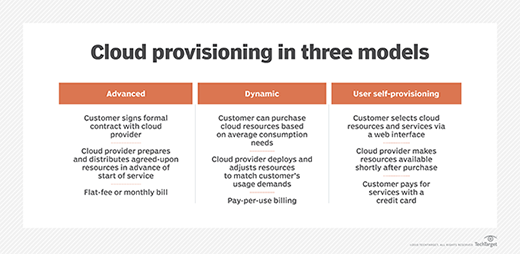cloud provisioning
What is cloud provisioning?
Cloud provisioning is the allocation of a cloud provider's resources and services to a customer. It's a key feature of the cloud computing model, relating to how a customer procures cloud services and resources from a cloud provider.
With cloud provisioning, customers can request and deploy virtualized IT resources on demand, including processing power, storage and network resources. The growing catalog of cloud services that customers can provision includes infrastructure as a service, software as a service and platform as a service in public or private cloud environments.
Types of cloud provisioning
The cloud provisioning process can be performed using one of three delivery models. Each delivery model differs, depending on the kinds of resources or services an organization purchases, how and when the cloud provider delivers those resources or services, and how the customer pays for them.
The following are the three models of cloud provisioning:
- Advanced provisioning. The customer signs a formal contract of service with the cloud provider. The provider then prepares the agreed-upon resources or services for the customer and delivers them. The customer is charged a flat fee or is billed every month.
- Dynamic provisioning. Cloud resources are deployed to match a customer's fluctuating demands. Cloud deployments typically scale up to accommodate spikes in usage and scale down when demands decrease. The customer is billed on a pay-per-use basis. When dynamic provisioning is used to create a hybrid cloud environment, it's sometimes referred to as cloud bursting.
- User self-provisioning. With user self-provisioning, also called cloud self-service, the customer buys resources from the cloud provider through a web interface or portal. This usually involves creating a user account and paying for resources with a credit card. Those resources are then quickly spun up and made available for use -- within hours if not minutes. Examples of this type of cloud provisioning include an employee purchasing cloud-based productivity applications via the Microsoft 365 suite or Google Workspace.

Benefits of cloud provisioning
Cloud provisioning offers organizations numerous benefits that aren't available with traditional provisioning approaches.
Benefits of cloud provisioning include the following:
- Scalability. In the traditional IT provisioning model, an organization makes large investments in its on-premises network infrastructure. This requires extensive preparation and forecasting of infrastructure needs, as the on-premises infrastructure is often set up to last for several years. In the cloud provisioning model, however, organizations can simply scale up and scale down their cloud resources based on short-term usage requirements.
- Speed. Organizations can also benefit from cloud provisioning's speed and faster deployment of cloud applications and services. For example, an organization's developers can quickly spin up an array of workloads on demand, removing the need for an IT administrator who provisions and manages compute resources.
- Potential cost savings. While traditional on-premises technology can require large upfront investments from an organization, many cloud providers let customers pay for only what they consume. However, the attractive economics presented by cloud services can present its own challenges, which organizations should address in their cloud management strategy.
- Accessibility. Cloud provisioning lets users access cloud-based data and apps from any location using any internet-connected device. This level of accessibility encourages and makes collaboration easier for remote work.
- Security. Cloud service providers often use stringent security measures to safeguard data and improve the cloud security posture. Most cloud providers use techniques such as strong encryption, access controls and frequent security updates to ensure the confidentiality and integrity of data.
- Disaster recovery. Cloud computing provides trustworthy backup and disaster recovery options. Data is stored in numerous locations, reducing the risk of data loss in the event of a hardware failure or natural disaster.
- Reduced IT maintenance. Cloud computing lets businesses delegate the tasks of hardware maintenance, software updates and security patches to the cloud service provider. Organizations can worry less about IT maintenance and instead concentrate on their core business activities.
Challenges of cloud provisioning
Cloud provisioning presents the following challenges to organizations:
- Complex management and monitoring. Organizations might need to rely on multiple provisioning tools to customize how they use cloud resources. Many enterprises also deploy workloads on more than one cloud platform, which makes it even more challenging to have a central console to view everything.
- Resource and service dependencies. Applications and workloads in the cloud often tap into basic cloud infrastructure resources, such as compute services, networking and storage. Beyond those, public cloud providers' big selling point is in higher-level ancillary services, such as serverless functions, machine learning and big data capabilities. However, those services can carry dependencies that might not be obvious, which can lead to unexpected overuse and surprise costs.
- Policy enforcement. A self-service provisioning model helps streamline how users request and manage cloud resources but requires strict rules to ensure they don't provision resources they shouldn't. Different groups of users require different levels of access and frequency. For example, a DevOps team might deploy multiple daily updates, while line-of-business users might use self-service provisioning on a quarterly basis. Organizations set up rules that govern who can provision which types of resources, for what duration and with what budgetary controls, including a chargeback system. Adherence to policies also creates consistency in cloud provisioning. For example, specify related steps such as backup, monitoring and integration with a configuration management database -- even agreed-upon naming conventions when a resource is provisioned to ensure consistency for management and monitoring.
- Cost controls. Beyond provisioning policies, automated monitoring and alerts about usage and pricing thresholds are essential. Be aware that these might not be real-time warnings; in fact, an alert about an approaching budget overrun for a cloud service could arrive hours or days after the fact.
- Vendor lock-in. Syncing apps and data between different cloud service providers can be challenging. Organizations can encounter difficulties when transferring their systems, or they might become dependent on a specific provider's product offerings, technologies or APIs.
- Compliance and legal issues. Cloud computing entails the storage and processing of data in third-party data centers, leading to potential compliance and legal considerations. Organizations must confirm that the cloud service provider complies with all relevant laws and industry standards.
- Specialized technical expertise. For organizations to properly manage and debug cloud infrastructures, specialist technical knowledge might be needed. To handle any potential problems, it's critical for the organization to have knowledgeable staff or easy access to trustworthy technical assistance.
Cloud provisioning tools and software
Organizations can manually provision whatever resources and services they need, but public cloud services offer tools to provision multiple resources.
Examples of cloud provisioning tools and software include the following:
- AWS CloudFormation. AWS CloudFormation is a service provided by Amazon Web Services (AWS). It lets users define and provision cloud infrastructure resources using templates. It also manages their lifecycle and helps them build and group related AWS resources.
- Google Cloud Deployment Manager. Google Cloud Deployment Manager automates the creation and management of Google Cloud resources through flexible templates and configuration files. Users can create deployments comprising various Google Cloud services such as Cloud Storage, Compute Engine and Cloud SQL, configured to work seamlessly together.
- IBM Cloud Orchestrator. IBM Cloud Orchestrator is a private cloud offering. It simplifies the management of enterprise-grade clouds by offering a core set of open source tools and components.
- Kubernetes. An open source container orchestration technology, Kubernetes automates the deployment, scalability and management of containerized applications.
- Microsoft Azure Resource Manager. Azure Resource Manager lets users provide, manage and arrange Azure resources in the cloud. It provides a unified API and a declarative syntax called Azure Resource Manager templates to define and deploy resources as a group.
Alternatively, the following are examples of vendors and their third-party tools for cloud resource provisioning:
- CloudBolt Software. CloudBolt is cloud management and cloud provisioning software. It lets enterprises automate cloud resource deployment and administration by offering a centralized interface for provisioning and monitoring.
- CloudSphere. Formerly known as HyperGrid and IQuate, CloudSphere is a cloud management and provisioning platform that supports multi-cloud settings and helps enterprises to automate the provisioning and management of cloud services.
- Flexera. Flexera, formerly RightScale, provides a cloud management platform with provisioning features. It helps enterprises to automate cloud resource deployment and management across different cloud providers.
- Morpheus Data. Morpheus includes modules for self-service and automated provisioning, resource configuration, monitoring, workload scaling, policy compliance and reporting. It supports multi-cloud settings and integrates with a variety of providers for automation, backup, identity and access management (IAM), IT service management (ITSM), monitoring, networking and security.
- Scalr. Scalr is a cloud management platform that prioritizes optimization and cost control. It provides provisioning capabilities and aids in the management of resource sprawl in virtual machine settings. Some organizations further automate the provisioning process as part of a broader cloud management strategy through orchestration and configuration management tools, such as HashiCorp Terraform, Red Hat Ansible, Chef and Puppet.
- Snow Software. Snow Commander, formerly Embotics, is a multi-cloud management platform that offers automated provisioning, resource configuration, monitoring and incident management capabilities. It's compatible with a variety of automation, backup, IAM, ITSM, monitoring, networking and security tools.
Managing costs in the cloud can be challenging. Learn which optimization strategies can help reduce costs.
This article is part of







